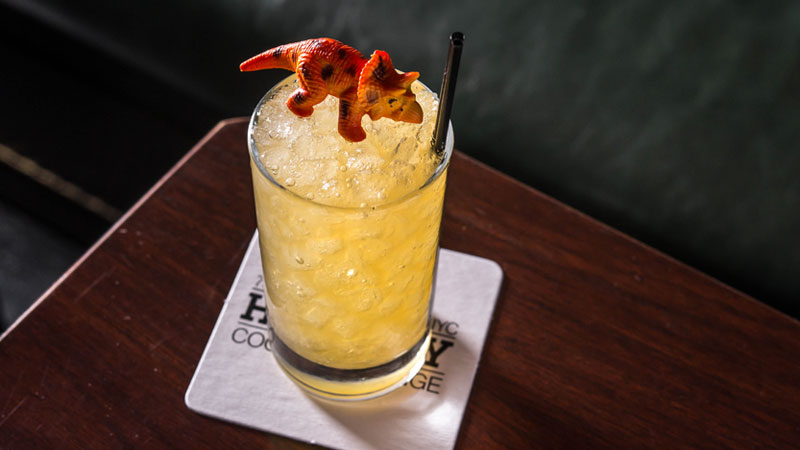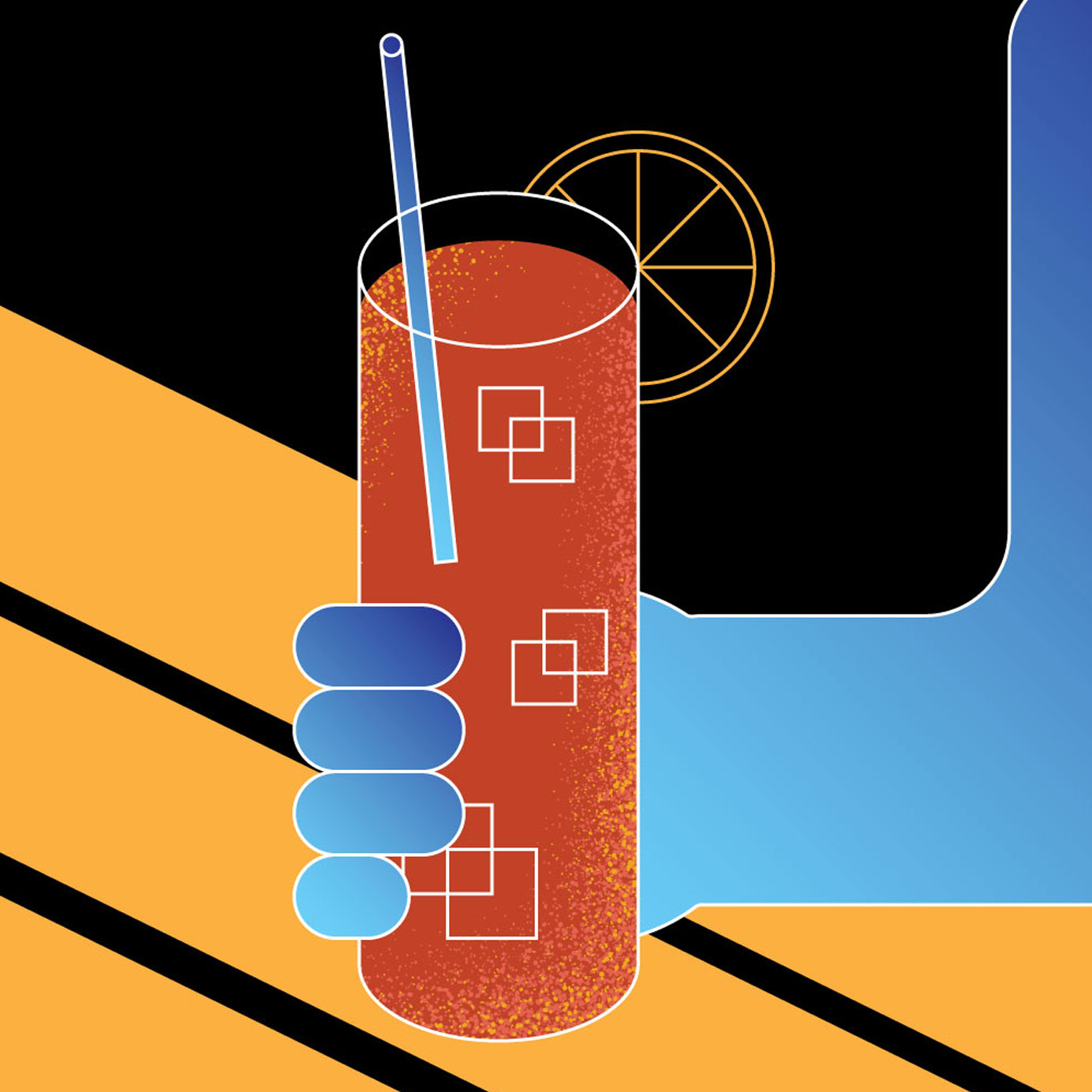Long Island Iced Teas are spirited enablers. Boozy, sticky-sweet, and often served in a vessel one can only describe as Big Gulp-esque, it’s one iconic cocktail most adults would just as soon forget.
And yet the stalwart mix of vodka, gin, tequila, rum, triple sec, and cola persists. It is an integral facet of American drinking culture to this day, motivating generations of partiers to live their best lives and make their worst decisions.
Why, though? Shouldn’t a drink with the sugar content of several fountain sodas and an impossibly high-proof punch fade to obscurity, especially in our moderation-minded, low-proof-seeking times?
Yes, but also no. Because for every generation of jaded, Negroni-sipping 30-somethings, there’s an endlessly renewing crop of energetic, wobbly-kneed Spring Breakers nipping at their heels. For them, Long Island Iced Teas (LIIT) are rich with wild potential. They speak to unbridled human spirit, a.k.a. the resting drink face of most 21-year-olds.
Regardless of age or experience, for some drinkers, the five-bottle fun has always just begun. The LIIT is timeless.
*
I can’t remember the last time I had a Long Island, but I do remember my first one. It was around 2004 or 2005 when I, fake ID in hand, staggered up to the bar at the Lexington, a now-shuttered dingy lesbian dive in San Francisco (God rest its perfect, disgusting soul). Some older friends had ordered Long Island Iced Teas, so I took a leap from my usual Malibu and pineapple and jumped on the cola-splashed train.
For a 19-year-old accustomed to alcohol meaning one of two things, fruity or forty, it was a revelation: sweet and crisply effervescent with that resounding smack of cheap vodka that lets you know it’s working. It was basically the best soda ever. And it got you tanked for something like $6. I was hooked, and for longer than I might now care to admit.
*
Much like a morning after too many LIITs, the cocktail’s origin is a foggy mystery. While many assume it was invented in Long Island, New York, others trace its invention to a historic mid-river hamlet in Kingsport, Tennessee called, you guessed it, Long Island.
According to a video produced by the Visit Kingsport tourism board, some Tennesseans attribute the drink to a Prohibition-era bootlegger named Charlie Bishop, or, more familiarly, “Old Man Bishop.” Multi-ingredient cocktails were all the rage during the dark, dry days between 1920 and 1933, due mainly to the pervasive lack of quality liquor. By adding some sugar syrup, fruit juice, or fizzy water, you could mask crap booze’s signature burn and turn it into something drinkable.
At some point during the 1920s, the legend goes, Bishop found himself with some extra homespun hooch. So he did what any of us would do and batched five of his spirits together (rum, vodka, tequila, whiskey, and gin) and hit the mixture with a splash of maple syrup. What resulted was a concoction that was both palatable and covertly amber-hued, like an iced tea.
Later, in the 1940s, Bishop’s son Ransom (yes his name was Ransom Bishop) put his own spin on things, dropping the maple syrup in favor of a livelier blend of lemon juice, lime juice, and cola. And, voila, the LIIT was born.
Now let’s jump ahead to the party-hearty 1970s, the setting of the LIIT’s alternate origin story. A man named Bob “Rosebud” Butt was behind the bar at Oak Beach Inn (OBI) East, a popular beach club in Hampton Bays, Long Island. According to yet another YouTube gem, this time from PBS Digital Studios’ INVENTORS series, the bar challenged its staff to a cocktail competition.
Butt, who claims to have had no prior knowledge of Bishop’s boozy mishmash of yesteryear, took home the gold with a soda-machine-suicide-style mix of all the clear liquors in house: vodka, gin, light rum, tequila and triple sec. To this he added sour mix and “a little Coke, just to make the color,” Butt tells the viewer.
“I invented it for fun, it was part of my job, and I think I always did my job well,” he says. “This is a good one, this is a real good drink,” he recalls thinking.
To OBI’s hot-pants-clad revelers, Butt’s cocktail was a game changer, a wholly new idea. It was an instant hit, a right-place-right-time creation that fell perfectly in line with the decade’s tall, sweet, and fruity “disco drinks.” It was also an ideal beach bar menu item: cheap for bars (thanks to well liquors and sour mix) and refreshing for consumers.
*
Back in 2005, I took my newfound go-to drink order with me from San Francisco to New York. I slightly altered it to a “Long Beach,” though, which an older, wiser friend (read: age 22) explained was a Long Island with cranberry juice instead of Coke —much more sophisticated.
My spot became the Holiday Cocktail Lounge, a grimy, age-old East Village dive I had first frequented in high school, thanks to its devil-may-care attitude toward proper identification. For the next few years, I spent many nights smashing the Holiday’s jukebox buttons, a tall glass of cherry-red liquid firmly in hand.
In 2012, Holiday Cocktail Lounge closed, going the way of CBGB’s, Mars Bar, and countless other beloved neighborhood shitholes. Three years later, seasoned NYC cocktailers Michael and Danny Neff reopened the place, giving everything inside, including the bar program, a good scrub.
At first I refused to return post-makeover. I just couldn’t risk sullying my beautifully sullied past. So imagine my surprise when reputable sources starting heralding the Holiday’s Long Island Iced Tea as one of the city’s best.

The Long Island Iced Tea at NYC’s Holiday Cocktail Lounge swaps in fresh lemon for sour mix, and features housemade black tea syrup instead of soda-gun cola. Credit: Holiday Cocktail Lounge
Erik Trickett, the Holiday’s current bar director, explains that the LIIT became one of the joint’s most notable offerings on a lark. “I was dating this girl and she was talking about how douchey Long Islands are or whatever,” Trickett says, “And I was like, ‘You know what? Honestly, it’s a good sour—a whiskey sour, John Collins, Tom Collins, it’s the same as all these drinks.’”
Trickett and his date went to Extra Fancy, the Williamsburg bar where Danny Neff worked at the time, and ordered a LIIT to see how a seasoned bar pro might handle the drink. “We walked in, I ordered, and of course Danny made me a beautiful and balanced cocktail,” Trickett says.
That’s when it all came together. “A few weeks later we were talking about opening this bar and putting some cocktails on our soda gun,” Trickett continues. “And I was like, ‘Dude, we should just put the Long Island on the soda gun.’”
Neff, for his part, called this “‘the stupidest, most amazing idea ever,’” Trickett says. “So for the first year and a half we served short Long Islands in these little water glasses over crushed ice. It was six bucks, a little smasher, and it was just boom, boom, boom.“
The Holiday now serves its Long Island in a traditional tall glass, but the concept remains the same since the soda gun days. The guys start with the requisite spirits, but sub in Torres Orange, an orange liqueur made with Spanish brandy, for the triple sec. They also use fresh lemon instead of sour mix, and a housemade black tea syrup in place of Coke.
The Holiday’s LIIT tastes fantastic, bright and tangy, with a hint of tequila bite and a smooth, rounded sweetness. It is thoughtfully updated yet obviously reminiscent of the alcopop of yore.
*
In some ways, the reimagined cocktail reflects the bar’s own reinvention, and suggests where American cocktail culture could be headed — provided we are willing to re-examine some of our more precious impulses.
The post-makeover Holiday retains some of the OG dive’s spirit. It has the same vintage jukebox, rickety wooden phone booth, horseshoe-shaped bar, and 4:00 a.m. last call as in years past, but it’s now got shiny, unblemished leather banquettes, an upgraded menu, and, well, it smells a whole lot better. Despite these fundamental improvements, the bar still feels fun and raucous, with the tiniest bit of edge, like anything could and might happen.
“I mean, we’re not Death & Company, we’re not Amor y Amargo, we’re not Leyenda, all these beautiful bars that do craft cocktails and do them remarkably well, you know?” Trickett says, rattling off some of NYC’s esteemed cocktail destinations. “We do things well, but we also serve everything with a little ‘fuck off’ attitude.”
One of the first T-shirts the bar made after its 2015 reopening said “Holiday Cocktail Lounge — Liquid in a Glass.” It was a clever tag, and a brush-off to the self-impressed cocktailers who dominated NYC bars in the early aughts, fretting over housemade bitters and rare Italian amaro instead of remembering that drinking is supposed to be, well, fun.
“The Long Island is the perfect representation of ‘liquid in a glass,’” Trickett says. “Black tea syrup is what we make for it, but we’re also happy to put Coke in it if you want. Our whole ethos is that when you come here, you can have whatever you want as long as you’re having a good time, but we’re also going to make sure that part of that great time is that you’re drinking something that you care about.”
That high-low dichotomy, the ability to adapt without losing face, might just be the secret to the LIIT’s remarkable staying power. The drink may have a quasi-moonshiner, Hamptons-pool-party past, but it’s still a worthy foil in the right hands.
After all, in recent years, bartenders have re-embraced what Jeffrey Morganthaler calls “trashy disco drinks” like Midori Sours, and turned once-maligned ingredients like banana liqueur into thoughtful cocktail components. Why shouldn’t the Long Island Iced Tea remain in the cocktail canon?
“A lot of cocktail bartenders, especially younger cocktail bartenders, have the impression that the Long Island is just a trash drink,” Trickett says. “I’m old enough to remember when everything was vodka and apple Martinis and you had to turn somebody over and bend their arm back to get them to order an Old Fashioned.”
Drinks culture is not stagnant. It changes constantly, often in tandem with larger social movements. As American cocktail culture evolves from early aughts’ mixology into the present day, the LIIT remains, and is absolutely ready go another round.
“Ultimately the pendulum swings,” Trickett says. “The Long Island is the epitome of that. It’s not fancy, it’s not pretentious or perfect, but for us, it’s an example of how everything can be made well. That pretty much sums it up.”
